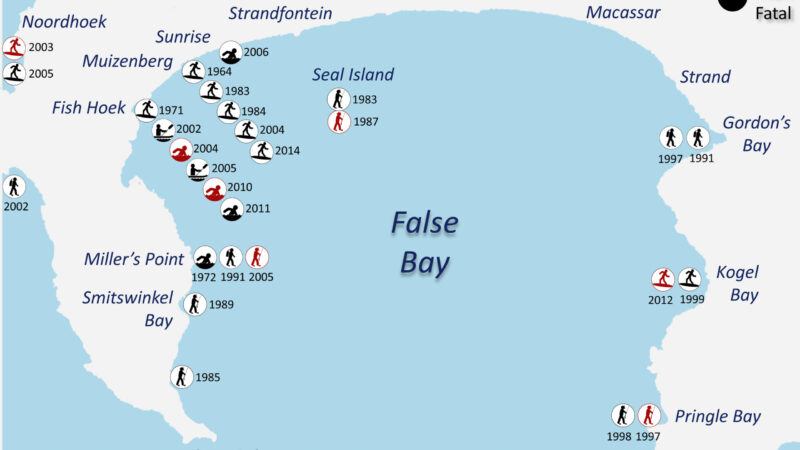Professor Alan Whiteside takes a wide-ranging look at the Covid-19 pandemic, both in South Africa and globally. From infection rates to excess mortality, and from the Cummings effect in the UK to the reliability of statistics in Africa, he concludes that there is a great deal we do not know. He says though that while the initial responses may have been appropriate, they need to be revisited. He pays particular attention to the validity of severe lockdown measures, concluding that we must learn to live with the virus, balancing it with other health and economic challenges. – Renee Moodie.
Covid-19 Watch: I don’t think I understand anything anymore!
By Professor Alan Whiteside*
Introduction
The year I turned 50, rather a long time ago, I decided I wanted to acquire three new skills. These were learning to fly a small plane; bodyboarding (I recognised ‘standing-up’ surfing was already beyond me); and ballroom dancing. I tried all and can do none.
Flying was fantastic fun. I accumulated 24 hours, but the minimum to get a license is 44. Taking off was amazing: powering down the runway; pulling back the stick; lifting off; levelling out to pick up more speed; and then up and off. The problem was landing – the instructor said, “Alan I can teach you how to fly, but I can’t teach you how to land, you have to feel the moment when the wheels touch down and you take the power off.” Thinking, talking, and writing about Covid-19 feels a bit like this. We got up, and now do not know how to get down, making up the checklists as we go.1

This week I want to pose a conundrum and ask if anyone has any insights. The conundrum is: at the beginning of the epidemic it was suggested the virus would rampage through populations. So far it has not, or at least not to the levels predicted, and this is especially the case in Africa at the moment. It was discussed in the covid19ssa Google group chat I am a part of. One contribution was headed ‘a tempest in a teapot?’.
In the UK Professor Neil Ferguson, of the School of Public Health at Imperial College London, was asked in February if an
“infection rate of 60% was realistic, he replied: ‘Potentially. Given we know a lot about how these viruses are spread we have lots of data from past epidemics. Given how transmissible this virus appears to be and the fact that at least all adults can be infected … then 60% is a reasonable figure for the epidemic size. Within the first 12 months or so. What we don’t know at the moment is of everybody infected, what proportion might die and what are the risk groups? Our best estimates at the moment is that maybe 1% of people who get infected might die.’”2
I will, as per usual, begin with data and for a little bit of light relief talk about a new syndrome or rule – I am not sure what the right word is. The Lancet published a brilliant letter by Francourt, Steptoe and Wright, complete with extensive supplementary material, on The Cummings Effect.3 It is worth reading and wondering about the appalling leadership in the UK.
Read also: Alan Whiteside: Covid-19 is evolving, gets more complicated – global insights
The numbers
There are 20,307,862 Covid-19 cases globally [as of August 12]. The USA accounts for over a quarter, at over 5.1 million cases. Brazil is second, India third, Russia fourth and South Africa fifth. Mexico, Peru, Columbia, Chile, and Iran make up the next five, with the UK is in 12th place behind Spain. The number of new daily cases seems to be plateauing. Table 1 shows the top countries (and the UK) by total number of cases. There has been little movement in ranking, but the numbers climb. China’s numbers are static, and it is out of the table.
| Date | Global cases | Brazil | Chile∞ | India∞ | Mexico∞ | Peru∞ | Russia | South Africa | UK | USA |
|---|---|---|---|---|---|---|---|---|---|---|
| 15 Feb | 69,000 | 0 | 2 | 0 | 9 | 43 | ||||
| 4 Mar | 93,000 | 4 | 3 | 0 | 86 | 149 | ||||
| 18 Mar | 201,500 | 372 | 147 | 116 | 2,600 | 7,800 | ||||
| 1 Apr | 861,000 | 6,836 | 2,777 | 1,400 | 29,900 | 213,400 | ||||
| 15 Apr | 1,982,552 | 28,280 | 24,490 | 2,415 | 94,845 | 609,422 | ||||
| 29 Apr | 3,117,756 | 79,685 | 93,399 | 4,996 | 162,350 | 1,012,583 | ||||
| 13 May | 4,262,799 | 180,000* | 232,243 | 11,350 | 227,741 | 1,369,964 | ||||
| 27 May | 5,594,175 | 291,222 | 362,342 | 24,264 | 241,408β | 1,681,418 | ||||
| 10 Jun | 7,250,909 | 739,503 | 493,023 | 52,991 | 262,098 | 1,979,893 | ||||
| 24 Jun | 9,264,569 | 1,145,906 | 264,689 | 456,183 | 196,847 | 264,689 | 598,878 | 106,108 | 277,200 | 2,347,022 |
| 8 Jul | 11,830,885 | 1,668,539 | 312,911 | 742,417 | 261,750 | 312,911 | 693,215 | 215,885 | 286,979 | 2,996,098 |
| 29 Jul | 16,741,049 | 2,483,191 | 349,800 | 1,531,669 | 402,697 | 395,005 | 1,531,669 | 459,761 | 302,295 | 4,352,083 |
| 5 Aug | 18,541,862 | 2,801,921 | 362,962 | 1,908,254 | 449,961 | 439,890 | 859,762 | 521,318 | 307,356 | 4,771,087 |
| 12 Aug | 20,307,862 | 3,057,470 | 376,616 | 2,329,638 | 492,522 | 489,680 | 900,745 | 566,109 | 313,402 | 5,141,208 |
* estimate ∞ these countries were added and so the early data has not been extracted. β Data for the UK from Worldometer
When I first produced a table, on 8th April, it was to try to make sense of the data. China had 80,000 cases on 4th March, on 29th July there were just 86,990 cases and the curve is flat, so I exclude it. It is hard to compare absolute numbers when populations are so different. To make useful assessments we need to look at rates as is done in Table 2. Belgium has the highest global rate of 865 deaths per million but is not on the table. The UK is second. This table needs to be revised to take in the changes in death and infections rates. Next week!
| China | France | Italy | Russia | South Korea | South Africa | Spain | UK | USA | |
|---|---|---|---|---|---|---|---|---|---|
| Deaths (19 May) | 3.33 | 421.07 | 529.64 | 18.84 | 5.13 | 5.26 | 593.04* | 523.33 | 275.8 |
| Total cases (20 May) | 58.4 | 2,189 | 3,736 | 1,991 | 216 | 277 | 4,953 | 3,629 | 4,557 |
| Deaths (3 June) | 3.33 | 429.83 | 533.93 | 33.56 | 5.27 | 13.35 | 580.58 | 587.24 | 320.93 |
| Total cases (2 or 3 June) | 58.4 | 2,320 | 3,856 | 2,905 | 225 | 579 | 5,125 | 4,070 | 5,472 |
| Deaths (17 June) | 3.33 | 438.73 | 568.76 | 49.01 | 5.38 | 27.14 | 580.78 | 627.71 | 354.46 |
| Total cases (16 or 17 June) | 58 | 2,410 | 3,924 | 3,681 | 237 | 1,239 | 5,221 | 4,372 | 6,386 |
| Deaths (1 July) | 3.33 | 444 | 574 | 63 | 5 | 43 | 606 | 655 | 385 |
| Total cases (30 June or 1 July) | 58 | 2,516 | 3,976 | 4,393 | 249 | 2,432 | ° | 4,595 | 7,826 |
| Deaths (8 July) | 3 | 444 | 575 | 64 | 5 | 46 | 606 | 657 | 388 |
| Total cases (7 or 8 July) | 59 | 2,759* | 3,999 | 4,713 | 257 | 3,317 | ° | 4,209 | 8,877 |
| Deaths (22 July) | 3 | 449 | 581 | 93 | 5.7 | 122 | 608 | 688 | 451 |
| Total cases (21 July) | 60 | 2,804 | 4,073 | 5,606 | 277 | 7,630 | ° | 4,420 | 12,961 |
| Deaths (3 August) | 3 | 450 | 581 | 98 | 5.8 | 147 | 619 | 695 | 474 |
| Total cases (3 August) | 60 | 2,748 | 4,057 | 5,447 | 272 | 6,880 | 5,826 | 4,496 | 12,187 |
| Deaths (12 August) | 3 | 451 | 582 | 104 | 5.9 | 186 | 611 | 699 | 501 |
| Total cases (13 August) | 62 | 3,127 | 4,155 | 6,150 | 287 | 9,545 | ° | 4,607 | 15,532 |
*misread these data °data missing
In previous posts I talked about various sources of data. Initially, the only test available was an antigen test to tell if a person was currently infected. There are now antibody tests of varying accuracy to show if people have been infected. This is particularly important as, of those infected, 30 percent have no symptoms, but will be infectious for about 15 days; 55 percent have mild to moderate symptoms, but can infect others for up to 3 weeks; 10 percent have severe symptoms, and five percent have critical ones and may be infectious for at least a month.
How many people have been and will be infected?
We are aware the proportions of people who have been infected is low, far fewer than originally hypothesised. An excellent article in New Scientist provides data on this.7 Their graph, which includes confidence intervals, shows about 26 percent of Iranians, 20 percent of French citizens, 17 percent of Italians, seven percent of Swedes and Swiss, six percent of Americans and five percent of Britons have caught the coronavirus. The cruise ship, the Diamond Princess, was a perfect incubator and case study. In this setting, of the 3,711 people on board, and most were tested, 712 were infected, which made up only 19 percent of the total on board. Of those infected 13 died, a case fatality rate 1.8 percent.
Read also: Covid-19 Watch: Curves, peaks, and a question of faith – Prof Alan Whiteside. MUST READ!
Inevitably there are debates about the disease and its consequences. In the UK the government is advised by the Scientific Advisory Group for Emergencies (SAGE).8 It was less than transparent which led to the establishment of the Independent Sage which aims ‘to provide robust, independent advice to HM Government with the purpose of helping the UK navigate Covid-19 whilst minimising fatalities’.9 In South Africa the government’s Ministerial Advisory Committee on Covid-1910 is dominated by medics and medical professionals. It has been criticised as not being representative.11 An alternate group: Pandemics: Data & Analysis (PANDA) has been established and claims to be ‘a multidisciplinary group seeking to inform policy …(and) consider(s) explanations that allow us to count the human costs of Covid-19 in South Africa’. It too is not representative.12 Having experienced the Mbeki denial of AIDS in 2000 I am cautious of harmful dissent and division. Equally science must be about testing ideas and have room for disagreement and debate. We would do well to remember the consequences of Lysenkoism.13
BizNews carried an interview with actuary Nick Hudson. He said, explaining the relatively small proportion of infections:
“there’s a big portion of the population who are simply not susceptible to a severe disease course. … But now – in paper after paper – it’s become clear that what we thought was the case is, in fact, the case – and that is that, you know, anywhere between 50 and 80% of the population are able to fight the disease of using the first layer of the immune defence system, which is called your cellular immune system or your T cells. And if you fight a disease or the virus off with your cellular immune system – you may go on not to produce antibodies and then you will never test positive on a seroprevalence test.
So, the majority of the population just shrug it off and they never even know that they had the virus in their cells – their bodies just deal with it. I like to replace the word immunity with resistance, because people understand it a bit more easily … your T cells are on the lookout for the proteins that are involved in this coronavirus.”14
The role of T Cells was also recently referred to in the Washington Post:
“Recent studies have suggested that antibodies from the coronavirus seem to stick around for only two to three months in some people. While work on T cells and the coronavirus is only getting started — testing T cells is much more laborious than antibody testing — previous research has shown that, in general, T cells tend to last year’s longer.”15
The implication of the discussion above is to re-emphasise that there is a great deal we do not know, and while the initial responses may have been appropriate, they need to be revisited. Here we run into inertia and confirmation bias. This view of the response is beginning to be discussed by other authors (see below).
Are we losing our sense of perspective?
The Lancet just published a letter from two medics based in Malawi and the DRC respectively who are questioning the rigorous measures of prevention and lockdown. They argue for accurate predictions and a recognition of death tolls attributable to the prevention measures. They suggest
‘SARS-CoV-2 might cause infection rates well below 30%, thus unable to provoke herd immunity but most probably causing recurring annual infections … Estimated infection fatality rates of around 0·3% draw a much less dramatic picture of Covid-19-related deaths … and estimates put the prioritisation of this disease over other health threats on the continent immediately into question’.
Kalk and Schultz suggest lockdown measures
‘do not appear applicable to the African continent and might cause more harm than SARS-CoV-2 itself. We have already seen the cumulative effects of psychosocial, economic, and health damage, including hunger, altered health-seeking behaviour, and postponed treatment.’16
Their conclusion is that we must learn to live with the virus, balancing it with other health and (in my view) economic challenges. They propose following the “well established public health principle: equal attention to equal health threats”. As Bill Gates is switching his focus to Covid this is going to have collateral consequences.
“Bill Gates says his foundation, the world’s wealthiest charity, will give its ‘total attention’ to the Covid-19 pandemic — even at the risk that its other public health work will suffer.”17
Is excess mortality a useful concept?
Given that most cases go undetected, the number of severe illnesses and deaths are small, thus, until recently, the main reliable source of data was mortality (deaths). Most countries collect vital statistics: births, deaths, or marriages. Death data usually includes the age and gender of the deceased and may give a cause. In the Covid-19 era the concept of excess deaths has been widely used. This is where the average number of deaths for previous periods is presented which shows the sharp increase that can then be attributed to Covid (or its consequences). It includes the deaths of those who do not access health care, because of fear or because facilities are overwhelmed. We are now beginning to see these declining and in some settings the graph of current deaths has fallen below the average. What are we to make of this? What are the policy implications?
The BBC has a brilliant programme ‘More or Less: Behind the Stats’ which tries to make sense of a range of data, not just Covid-19. They mentioned South Africa and Zambia as being the only two African countries with decent death data, noting that information on the cause of death lags by a year in South Africa.18
The European epidemic
The trends
There has been a concerning increase in the number of cases across several European countries. The Economist produces graphs using a seven-day moving average. On 11th August this showed cases had increased significantly in Belgium from 0.64 to 5 per 100,000, in Spain from 0.86 to 7.9, and in the Netherlands from 0.35 to 3. There have been smaller increases in all other countries except Portugal and Luxembourg, where the numbers are going down.19 The message is that constant vigilance is crucial. There are variations within countries and these hotspots need rapid intervention. In England, Preston, in Lancashire, is the latest UK city to come under increased local lockdown restrictions. The rate of new Covid-19 cases went up from 20.3 per 100,000 people in the week ending July 27 to 32.8 in the week ending August 3rd. The good news across Europe is that the number of deaths has fallen dramatically and consistently.20
The Cummings Effect
The British public have an increasing distrust of authority. This is not always a good thing. Regarding public health messages (the clue is in the word ‘public’), governments want people to take them seriously. This requires trust. In England, the initial slogans on the podiums at the nightly coronavirus briefings were “stay home, protect the NHS, save lives”. For an excellent discussion of messaging see Julia Pierce in The Conversation 15th May, ‘Feeling alert? Where the UK government’s new coronavirus campaign went wrong’.
‘The UK is in the process of acclimatising to Prime Minister Johnson’s “conditional plan” to ease lockdown measures. This includes … replacing the message to “stay home, protect the NHS, save lives” with the instruction to “stay alert, control the virus, save lives”. The shift in message has not been well received. A lack of clarity and actionable advice have been highlighted … only 30% … felt the new message “makes it clear what I am supposed to do”.’21
A week later The Guardian and Daily Mirror newspapers published details of Dominic Cummings,22 a senior advisor to Johnson, breaking the rules. He travelled from London to Durham with his unwell wife and child. Whilst in the area the family also took an illegal side trip to Barnard’s Castle. There was immediate widespread condemnation, but no admission of guilt or apology from Cummings or any politicians. Indeed his actions were defended. At the time we watched and wondered what effect his actions and the political response would have on compliance to public health messages and public behaviour. A YouGov poll reported in the Guardian “found 71% of the public thought that Cummings had broken the lockdown rules and 59% thought he should resign”.23
The Lancet article presents analyses of 220,755 surveys from 40,597 individuals in England, Scotland, and Wales, between April 24 and June 11, 2020, by University College London’s Covid-19 Social Study. The Cummings debacle significantly undermined confidence and compliance. Two questions were:
- “How much confidence do you have in the UK GOVERNMENT that they can handle Covid-19 well? If you live in a devolved nation, we ask you to focus on the government within your country (e.g. the Scottish government / Welsh government / Northern Ireland Executive)”.
- “How much confidence do you have that the UK HEALTH SERVICE can cope during Covid-19? If you live in a devolved nation, we ask you to focus on the health service within your country (e.g. NHS Health Scotland / NHS Wales / HSCNI)”.
Confidence in the English government started to fall after the lockdown easing was announced but plummeted after the Cummings affair. There was some decline in confidence in Scotland and Wales but not to the same extent. The data show those questioned maintained confidence in the abilities of their respective health services.
The authors note:
“Public trust in the government’s ability to manage the pandemic is crucial as this trust underpins public attitudes and behaviours at a precarious time for public health. Our data show how closely public confidence is related to government announcements regarding Covid-19. After an initial increase in public confidence … the government’s announcement on May 10, 2020, that society would begin to reopen in England through a staged series of lockdown easing measures as part of a new Covid-19 alert level system was followed by a decrease in confidence. … confidence stabilised and even improved slightly in England in the fortnight following these events, until the Cummings effect.”24
It plummeted and remains low.
Conclusion
The process of preparing this weekly blog is interesting. The BBC programme ‘The Moral Maze’ had one ‘witness’ suggesting that the global response was defined by what the Chinese did, and their draconian response was, for the most part, simply copied. Is it a question of lives versus liberty or lives versus lives? Where should economics fit? We need to recognise the almost certain decline in international development assistance and the need to reprioritise.
I am not able to focus on the global situation and so my watchword is to write about areas I know and try to pick up interesting events or facts. It seems though that countries are not really learning from each other. If I had not gone to the Economist Covid-19 site, tracking the European epidemic, I would not have known that the Netherlands are seeing a rapid increase in the number of cases. The peak was 6.5 per 100,000 in April, it fell to 0.31 in July but has since risen to 3.25 I have been making use of the “eat out to help out” scheme, which the BBC reported was used more than 10.5 million times in its first week.26 The government will pay for 50% of a meal eaten at a cafe, restaurant or pub, capped at £10 and excluding alcohol, on Mondays, Tuesdays or Wednesdays. It will run through the month of August. My policy is to add to the tip! The government claims it is making a difference.
- Thank you for reading, reposting and providing comments. What I write is public domain so please share, forward and disseminate. My contact is: [email protected]
- Professor Alan Whiteside, OBE, Chair of Global Health Policy, BSIA, Waterloo, Canada & Professor Emeritus, University of KwaZulu-Natal www.alan-whiteside.com
- An excellent book to inform the way we think is The Checklist Manifesto by Atul Gawande is (Henry Holt and Company, 2009).
- Daisy Fancourt, Andrew Steptoe and Liam Wright, The Cummings effect: politics, trust, and behaviours during the COVID-19 pandemic, The Lancet 6th August 2020
- These data are from Johns Hopkins University
- The UK data from 27th May is taken from Worldometers.info.coronavirus/country/uk
- Deaths
Case per million ourworldindata.org/grapher/total-confirmed-cases-of-covid-19-per-million-people - The voices missing from South Africa’s response to COVID-19
- Please read up on this horrific misdirection of science, a good place to start is Wikipedia
- Andreas Kalk and Andreas Schultz, SARS-CoV-2 epidemic in African countries—are we losing perspective? August 07
- Who is Dominic Cummings? There is a saying in public relations that when an advisor becomes the story it is time to go! Cummings is an odious Tory advisor to Boris Johnson. He is also a Brexiteer. See the Wikipedia page
- Stewart, Heather; Mason, Rowena; Proctor, Kate (27 May 2020). “Dominic Cummings: Tory unrest increases pressure on PM to sack adviser”. The Guardian.
- Fancourt et al op. cit





Recent Comments